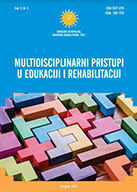CAMOUFLAGING AND AUTISM SPECTRUM DISORDER: A SYSTEMATIC REVIEW
CAMOUFLAGING AND AUTISM SPECTRUM DISORDER: A SYSTEMATIC REVIEW
Author(s): Ajla Bukva, Daria ZečevićSubject(s): Education, Psychology
Published by: Udruženje defektologa, edukatora-rehabilitatora (STOL)
Keywords: autism spectrum disorder; autism; camouflaging; sex/gender differences; mental health;
Summary/Abstract: In order to fit into the environment, satisfy social norms, and increase the opportunities of creating successful interpersonal interactions, individuals with autism spectrum disorder (hereinafter referred to as ASD) often try to develop coping strategies, and one such strategy is camouflaging. Camouflaging can be seen as a way in which individuals try to hide the less desirable aspects of their personality. The aim of this review was to determine the sex/gender differences in the representation of camouflaging in individuals with ASD by reviewing the relevant literature, to determine the impact of camouflaging on mental health, as well as the reasons and consequences of the camouflaging. By searching the SCOPUS database and after applying inclusion and exclusion criteria for publications in the field of autism spectrum disorder and camouflaging, a total of 10 publications were included and analyzed in the current review. Results show that individuals of the female sex/gender with ASD report higher levels of camouflaging compared to individuals of the male sex/gender with ASD. In addition to the above, it has been found that camouflaging is associated with mental health challenges. The results showed that individuals of the female sex/gender with ASD were more supportive of conventional reasons than individuals of the male sex/ gender with ASD. The results of research on the consequences of camouflaging show that people with ASD who camouflage themselves most often feel unhappy because they perceive camouflaging their true identity and personality as lying and deceiving about who they really are. Also, research indicates that thanks to camouflaging, individuals with ASD did not encounter the stereotype of “autistic person”, however, this caused negative consequences such as delaying or questioning their diagnosis of ASD, especially in individuals of female sex/gender with ASD.
Journal: Multidisciplinarni Pristupi u Edukaciji i Rehabilitaciji
- Issue Year: 5/2023
- Issue No: 5
- Page Range: 111-132
- Page Count: 22
- Language: English

